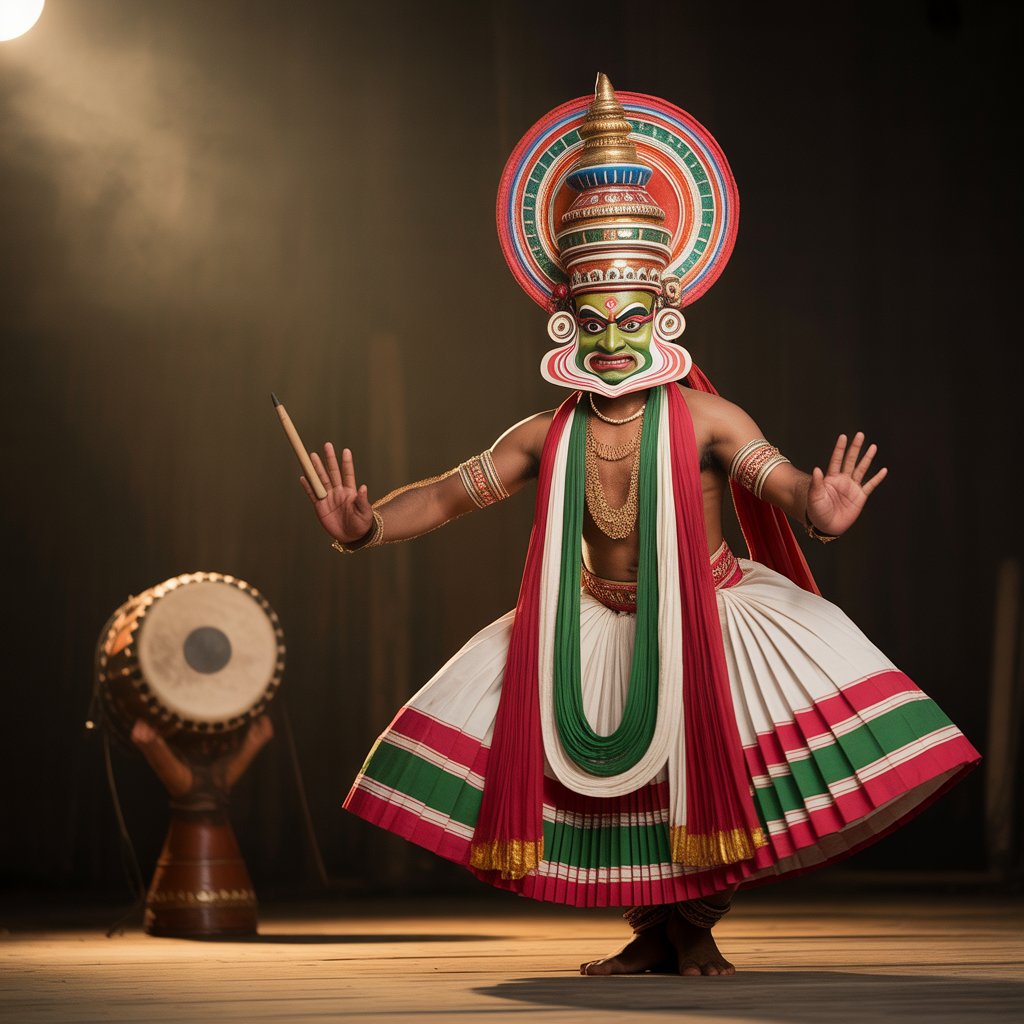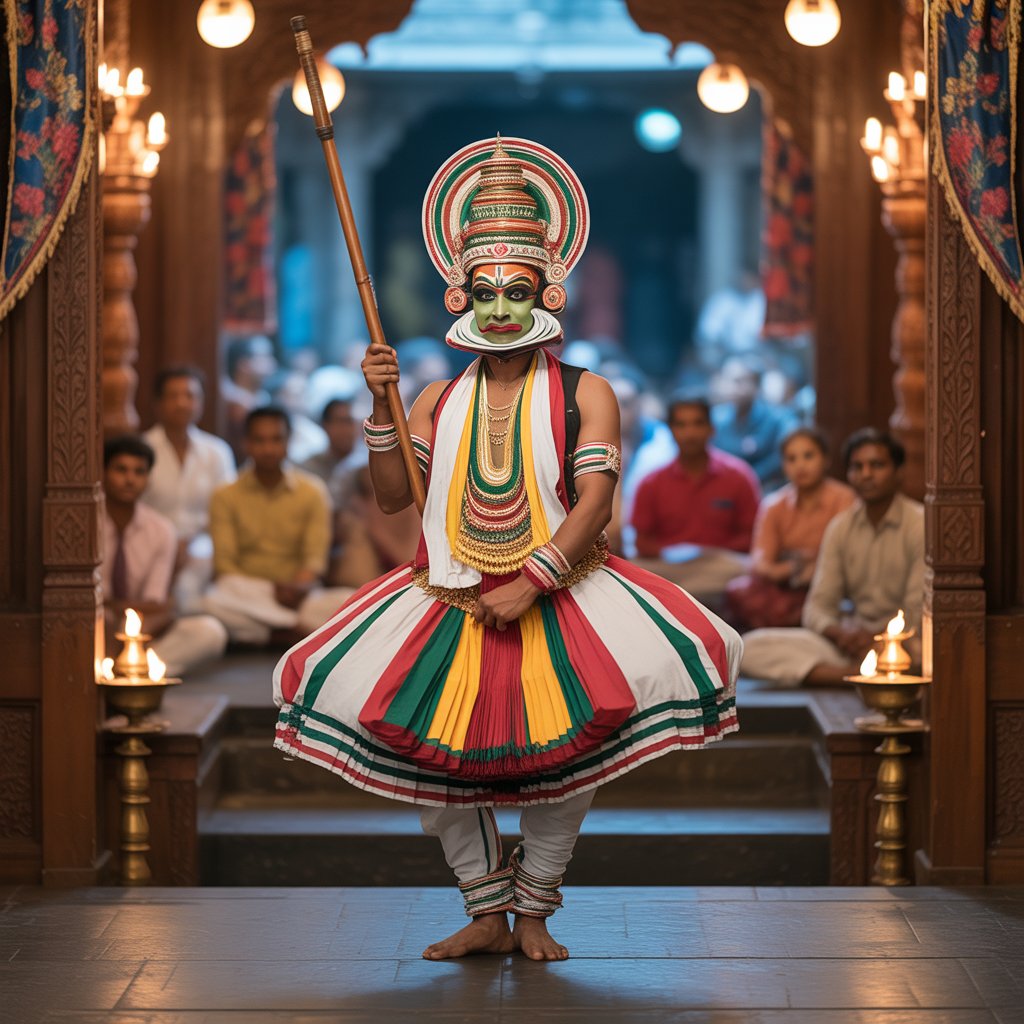Kathakali Dance is one of India’s most vibrant and iconic classical dance forms, originating from the lush state of Kerala. Renowned for its elaborate costumes, vivid face makeup, and dramatic storytelling, Kathakali brings ancient myths and legends to life on stage. This dance combines intricate gestures, expressive facial movements, and powerful music to create a mesmerizing theatrical experience. More than just a performance, This Dance is a cultural treasure that reflects Kerala’s rich heritage and artistic legacy. Whether you’re a cultural enthusiast or a curious traveler, discovering Kathakali Dance offers a glimpse into India’s timeless traditions and living art.

The History and Evolution of Kathakali Dance
The basic components and distinct features of this form of classical dance can be traced back to an ancient Sanskrit Hindu text called ‘Naatya Shastra’, a text on the performing arts written by the sage Bharata Muni, an Indian theatrologist and musicologist. Kathakali emerged in the 17th Century as a synthesis of earlier dance-drama traditions, including Kutiyattam and Krishnanattam, with its most direct predecessor being Ramanattam.
Famous Kathakali Dance Stories and Themes
Kathakali Dance draws its powerful narratives from ancient Hindu epics like the Mahabharata and Ramayana, as well as from local folklore and classical literature. Some of the most famous stories performed in Kathakali include tales like Nalacharitam (the story of King Nala and Damayanti), Kalyanasougandhikam (Bhima’s quest for the divine flower), and episodes from Ramayanam such as Keechaka Vadham (the slaying of Keechaka). These timeless stories explore universal themes of good versus evil, love, betrayal, and heroism. Through elaborate expressions, gestures, and striking visuals, Kathakali Dance transforms these epic tales into a mesmerizing stage spectacle for audiences of all ages.
Symbolic Costumes and Makeup: The Art Behind the Masks
One of the most striking features of Kathakali is its vibrant and elaborate costumes. Performers don brightly colored, layered garments, adorned with intricate embroidery and jewelry. The headgear, often towering and elaborate, signifies the character being portrayed.
The makeup, known as Chutti, uses vivid colors like green, red, black, and white to symbolize the nature of each character: green for heroes and gods, red for evil, and black for forest dwellers or hunters. The towering headdresses, ornate jewelry, and layered skirts enhance the visual impact, turning the performer into a living work of art. Together, these elements bring out the grandeur and dramatic essence that make Kathakali Dance unforgettable.
Renowned Artists and Legendary Gurus
Kavungal Chathunni Panicker, a celebrated and veteran performer of this field, is a scion of the famous Kavungal family associated with ‘Kathakali’ for six generations. Kalamandalam Gopi, a renowned name in ‘Kathakali’ with a career of over 30 years, is one of the most eminent representatives of the Kalluvazhi School of Kerala. Another famed ‘Kathakali’ actor, Kottakkal Sivaraman, who portrays feminine characters, emotes different nayika bhavas, such as lasya nayika and vasakasajjika, with great élan. Kalamandalam Ramankutty Nair is a seasoned ‘Kathakali’ performer who not only earned fame for portraying negative characters like Ravana and Duryodhana but also proved his mettle in characterising Lord Hanuman. Other imminent ‘Kathakali’ performers include Kalamandalam Krishna Prasad, Kalamandalam Vasu Pisharody, Kalamandalam Kesavan Namboodiri, and Kalanilayam Balakrishnan, to name a few.
Differences Between Kathakali Dance and Other Indian Classical Dances
While India is home to many beautiful classical dance forms, Kathakali stands out for its larger-than-life theatrical style and visual extravagance. Unlike dances like Bharatanatyam or Odissi, which focus on graceful body movements and fluid footwork, Kathakali is more dramatic and emphasizes elaborate costumes, towering headgear, and vibrant facial makeup to depict mythological characters. Another unique aspect is the use of mudras (hand gestures) combined with highly stylized facial expressions to narrate entire epics without spoken words. The performances are often accompanied by live vocal music and traditional percussion instruments. This makes Kathakali not just a dance, but a complete visual drama that brings ancient stories to life in a grand, mesmerizing way.
Impact of Kathakali Dance on Kerala’s Culture and Tourism
Kathakali isn’t just a dance form — it’s a living symbol of Kerala’s cultural heartbeat. For generations, it has shaped local traditions, temple festivals, and community gatherings, keeping age-old stories alive through mesmerizing performances. For locals, it’s a matter of pride; for visitors, it’s often the highlight of their Kerala journey. Many tourists flock to see a Kathakali show, fascinated by the artists’ dedication and the art’s timeless beauty. From village stages to international festivals, Kathakali acts as a cultural ambassador, drawing people into Kerala’s rich heritage. Its impact goes beyond entertainment — it boosts tourism, supports local artists, and inspires younger generations to preserve this magnificent tradition.

Kathakali is so much more than a performance — it’s an experience that stays with you long after the final drumbeat fades. Watching it, you don’t just see dancers on stage; you witness generations of stories, passion, and tradition coming to life in every gesture and glance. For the people of Kerala, Kathakali is a proud thread in their cultural fabric. For visitors, it’s a chance to connect with an ancient art that still feels alive and relevant today. If you ever get the chance to see Kathakali up close, take it — let the colors, music, and drama sweep you into a world where legends never grow old.
A Few Words to Conclude
Kathakali is so much more than a performance — it’s an experience that stays with you long after the final drumbeat fades. Watching it, you don’t just see dancers on stage; you witness generations of stories, passion, and tradition coming to life in every gesture and glance. For the people of Kerala, Kathakali is a proud thread in their cultural fabric. For visitors, it’s a chance to connect with an ancient art that still feels alive and relevant today. If you ever get the chance to see Kathakali up close, take it — let the colors, music, and drama sweep you into a world where legends never grow old.
If you want to know about other dance forms, please follow our channel, a2ztrendy.



